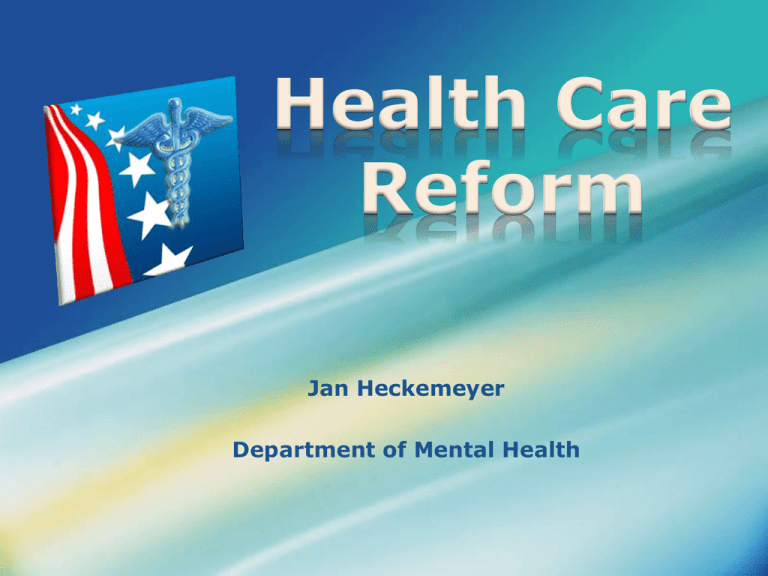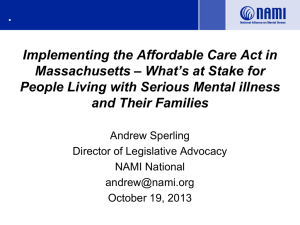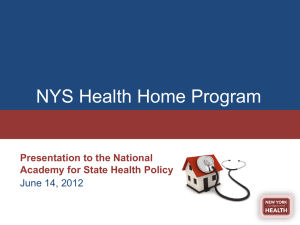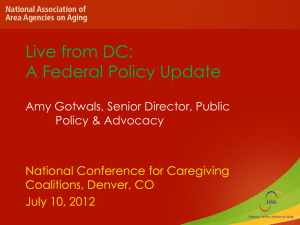Health Care Reform - Missouri Recovery Network
advertisement

Health Care Reform Jan Heckemeyer Department of Mental Health What is Health Care Reform? Patient Protection & Affordable Care Act (ACA) and the Health Care & Education Reconciliation Act of 2010; Enacted March 2010. Contains significant expansions of access and coverage for almost all Americans. Overarching Goals of Health Care Reform Increase number of people with health coverage Improve quality of health coverage Increase wellness and disease prevention efforts Insurance and payment reform Health Care Reform Uninsured Individuals: 46 million in United States 800,000 in Missouri The ACA will expand coverage to an estimated 32 million Americans, including 500,000 Missourians. Insurance Regulations Changes effective for health plan years beginning on or after September 23, 2010: Must provide dependent coverage up to age 26 Certain preventative services are covered without requiring co-payments or deductibles. Prohibits rescinding insurance coverage except in cases of fraud Prohibits annual and lifetime limits on coverage Children cannot be denied coverage because of preexisting conditions. Pending Legal Challenges Over 30 lawsuits have been filed in courts across the country to challenge the constitutionality of the law – primarily the “individual mandate”. The “individual mandate” requires most people to have insurance or pay a special tax; Larger businesses will also pay fines if they do not provide insurance to their employees. Five federal district courts have ruled on the merits of the individual mandate – three have upheld the constitutionality and two have struck it down. Two federal Court of Appeals have issued rulings – One upheld the law and the other ruled that the individual mandate was unconstitutional but the rest of the law was upheld. It is expected that the Supreme Court will ultimately rule on the constitutionality of the law. What is Health Insurance Exchange? Serves as a health plan shopping mall for individuals and small businesses seeking more stable health care rates and coverage. Employers with 50 or less employees and individuals (including those eligible for Medicaid) choose among plans offered through an Exchange. Provides quick, easy access to a menu of options for health insurance coverage comparing premium rates and benefit packages. Health Insurance Exchange Requirements Each state must establish a Health Insurance Exchange by January 1, 2014. Must be operated by a governmental entity or non-profit entity. For states that do not establish an Exchange, or if the state’s Exchange fails to meet Federal requirements, the Federal government will operate the Exchange. Exchange must make “qualified” health plans available to individuals and employers. Exchange must provide “no wrong door” portal for all consumers to determine eligibility and enroll in: Medicaid Children’s Health Insurance Program (CHIP) Premium tax subsidies to purchase private coverage Non-subsidized private coverage Missouri Action on Health Insurance Exchange Established Health Insurance Exchange Coordinating Council (HIECC). Received $1 million planning grant. Received approximately $21 million federal grant to help implement an Exchange. Legislation was introduced in last session to organize the Exchange as a quasi-governmental agency called the “Show-Me Health Insurance Exchange”. Legislation passed the House but was not voted on by the full Senate when the session ended in May. Show-Me Health Insurance Exchange Key Functions: Certify “qualified” health plans Screen Missouri residents for subsidies, including Medicaid Conduct outreach, education and assistance for individuals and small businesses seeking coverage HIE Navigators Navigators are entities that conduct outreach, education and enrollment into qualified health plans through the state Exchange. A state Exchange must establish a program under which it awards grants to Navigators. To be eligible to receive a Navigator grant, an entity must demonstrate that it has existing relationships or could readily establish relationships with employers, employees, consumers and self-employed individuals likely to enroll in qualified health plans through the Exchange. Potential Navigator entities include: Trade, industry, and professional associations Community and consumer-focused non-profit groups Chambers of commerce Unions HIE Navigators Duties of Navigators: Conduct public education activities to raise awareness of the availability of qualified health plans Distribute information concerning enrollment in qualified health plans and available tax credits and other costsharing reductions Facilitate enrollment in qualified health plans Provide referrals to appropriate state agencies or other health insurance consumer assistance offices Provide information in a manner that is culturally and linguistically appropriate to the needs of the population being served in the Exchange HIE Navigators Recommended State Timelines: 2011 – Preliminary planning activities including developing high level milestones and timeframes for establishing the Navigator program 2012 – Determine targeted organizations in the State who would qualify as Navigators 2013 – Award grants or contracts to Navigator entities; Train Navigators and begin operations Medicaid Expansion to 133% FPL Beginning January 1, 2014, states will be required to provide Medicaid benefits to uninsured individuals with household incomes up to 133% FPL who are: Under age 65, Not pregnant, Not entitled to or enrolled in Medicare Part A or B, and Not eligible for Medicaid under any other mandatory category. Medicaid Expansion to 133% FPL Missouri currently covers: Pregnant women and children Parents to approximately 20% of the FPL Permanently and totally disabled individuals under age 65 to 85% FPL Medicaid Expansion to 133% FPL % Gross Monthly Income Family Size 85% 100% 133% 1 person $772 $908 $1,208 2 people $1042 $1,226 $1,631 3 people $1,312 $1,544 $2,054 4 people $1,584 $1,863 $2,478 5 people $1,854 $2,181 $2,901 2011 FPL Guidelines Medicaid Expansion to 133% FPL States will receive increased federal financial participation for newly eligible individuals in the expansion group: 100% - 2014, 2015 and 2016 95% - 2017 94% - 2018 93% - 2019 90% - 2020 and thereafter Health Homes for Persons with Chronic Conditions States have the option of enrolling Medicaid beneficiaries with chronic conditions into a Health Home. A Health Home is a multidisciplinary team of health care providers who work together to ensure that a person has a regular primary care physician and that their care is coordinated so that all other health care providers involved know what each is doing and what a person needs next in order to have the best health care possible. A health home is responsible for making sure the patient gets all the care he/she needs, but does not have to provide all the care themselves. Health Homes for Persons with Chronic Conditions For the purposes of Health Homes, ACA considers the following to be chronic conditions: Serious Mental Health Conditions Substance Use Disorders Asthma Diabetes Cardiovascular Disease – including hypertension Overweight (BMI>25) Other conditions may also be included Health Homes for Persons with Chronic Conditions Eligible Individuals: Persons with 2 chronic conditions Persons with 1 chronic condition who are at risk for a 2nd chronic condition Persons who have 1 serious and persistent mental health condition Health Homes for Persons with Chronic Conditions Requirements: Care coordination and health promotion Comprehensive transitional care including follow-up from inpatient and other settings Patient and family support Referral to community and support services Use of health information technology to link services Health Homes for Persons with Chronic Conditions Missouri is the first state to submit a Medicaid state plan amendment to implement Health Homes. There are two types of Health Homes: Primary Health Care • Federally Qualified Health Centers (FQHCs) • Rural Health Centers (RHCs) • Physician Practices Behavioral Health Care • Community Mental Health Centers (CMHCs) and CMHC Affiliates Department of Mental Health Commitments Continue participation and support for Cabinet Team. Provide DMH representation on interagency groups. Educate DMH stakeholders about health care reform opportunities. Participate in statewide infrastructure development, such as the Health Insurance Exchange, changes to eligibility applications and Medicaid billing changes.







